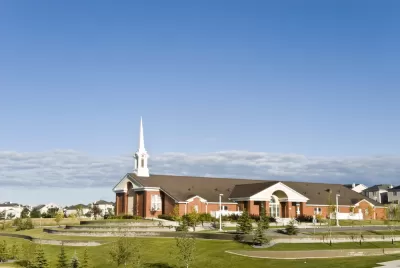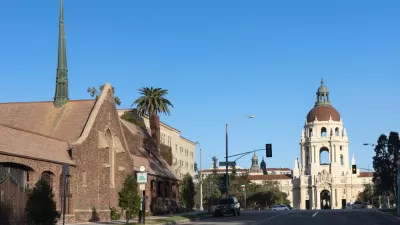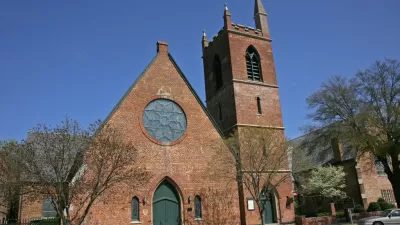By focusing on their common interest in working toward the public good, the gap between faith-based institutions and the planning processes of their communities can be bridged.

There exists in Calgary, as in most other municipalities, an institutional gap that reduces the well being of communities and makes long-term sustainability much more difficult. Despite each side having a long history of city building in Calgary, faith-based organizations and City of Calgary's planning process have been running on different voltages for decades. The city departments that balance land use processes and decision making speak an administrative and process language that is incomprehensible to the leaders and members of most religious institutions. Those institutions, in turn, have not paid recent attention to the long-term planning processes of the city. The faith-based institutional landscape is also very diverse and fragmented, so it is difficult for the formal planning administration to engage with them as institutional players.
Faith-based organizations lack the coherent organization equivalent to the Chamber of Commerce, for example. Ministerial groups and other denominational organizing efforts could be cited as a counterpoint to that claim, but these expressions of institutional collaboration are undertaken for purposes other than city building. Faith institutions may deliver service level work but rarely do they undertake the kind of long-term structural engagement that forms the core of city planning efforts.
The Canadian Revenue Agency requires that an organization desiring charitable status fulfill the charitable purpose category (defined as "relief of poverty, advancement of education, advancement of religion, or certain other purposes beneficial to the community in a way the law regards as charitable"). The institution in question must have a purpose that contributes to the common or public good. Having such a purpose, the institution can be considered to have paid its dues by providing benefit to others. In a complimentary way, the Canadian Institute of Planners, in their "Planners Code of Conduct," specifies that planners must encourage debate, exchange, and inclusive process in the service of the public good (including such matters as the ethical handling of economic and other privileged information).
Therefore, charities (a significant majority of which are religious in nature) and planning professionals alike have a public good requirement. The puzzle may be why that overlap is not more effectively developed and encouraged. I would assert that this gap in the social infrastructure of cities can, and should, be bridged.
We could begin thinking about bridging the gap by focusing on the idea of the common good. The term "public good" or "common good" is also embedded in the Municipal Government Act, a Province of Alberta document that mandates, among other things, that elected officials are required "to provide good government" in the service of public interest. As an example, hundreds of faith-based organizations serve a wide and significant number of citizen needs in Calgary. City planners attend to the balancing of highly complex needs and dynamics of nearly a million residents as distributed across the more than 700 square kilometers of land occupied by the city. What could more robust engagement around themes of common good look like for these respective facets of Calgary’s social infrastructure? What efficiencies or new energies might be released through social and institutional innovation in this space?
In all of this, neither city planners nor faith-based organizations are homogenous in their thinking or practice—there are clear differences between them that include legal, ethical, cultural and public aspects. Planners are naturally more concerned with the technical, concrete, spatial, and tangible aspects of the city (though planners are expected to far more than that), while faith institutions are concerned with matters of well being and spiritual care, purpose, meaning, and belonging. Finding greater common cause does not preclude respect for their necessary differences.
A recently released report that I worked on, "Strengthening Vital Signs Through Urban Religious Communities," is the culmination of various smaller projects that the think tank Cardus has undertaken since 2008 in the City of Calgary. The primary concern of the report is to explore the state of faith-based organizational and city planning collaboration. Based on consultations, primary document research, and community conversations, it is clear that the City of Calgary has shown remarkable insight in recognizing the value of that collaboration, even if it has not been as active in pursuing the fully potential of that collaboration.
In 2008, Cardus convened "Planning in Good Faith" in Calgary to draw attention to the deep and persistent role that faith-based organizations have played in city building. The new report takes considers what has been learned in Calgary since 2008 through the community consultations, faith and municipal leaders meetings, and events that Cardus has organized. Out of that work, the report poses the question, "Have faith institutions and city planners made sufficient use of their respective capacities in city building?" The answer is that there have been important gains but much remains to be done.
Faith-based organizations have not invested collectively in the structural processes of the city, though their insights into the deepest aspects of human thriving are much needed in the conversations of the public square. Creating coherent public space through new social infrastructure is a critical need. Effective city planning will be indispensable for a sustainable, resilient Calgary of the future, and planners can ill afford to overlook any community resources that can help to realize that vision. Finding new ways to cross this civic crevasse represents a significant opportunity for a city that is still defining what it will become.
Milton Friesen is Senior Fellow and Program Director of Social Cities at Cardus, a North American think tank, and he has served as an elected municipal official. His current Ph.D. work at the University of Waterloo, School of Planning, involves a new proposal for measuring social impact. He also participates in the Waterloo Institute on Complexity and Innovation. Complete bio.

Planetizen Federal Action Tracker
A weekly monitor of how Trump’s orders and actions are impacting planners and planning in America.

Maui's Vacation Rental Debate Turns Ugly
Verbal attacks, misinformation campaigns and fistfights plague a high-stakes debate to convert thousands of vacation rentals into long-term housing.

San Francisco Suspends Traffic Calming Amidst Record Deaths
Citing “a challenging fiscal landscape,” the city will cease the program on the heels of 42 traffic deaths, including 24 pedestrians.

Amtrak Rolls Out New Orleans to Alabama “Mardi Gras” Train
The new service will operate morning and evening departures between Mobile and New Orleans.

The Subversive Car-Free Guide to Trump's Great American Road Trip
Car-free ways to access Chicagoland’s best tourist attractions.

San Antonio and Austin are Fusing Into one Massive Megaregion
The region spanning the two central Texas cities is growing fast, posing challenges for local infrastructure and water supplies.
Urban Design for Planners 1: Software Tools
This six-course series explores essential urban design concepts using open source software and equips planners with the tools they need to participate fully in the urban design process.
Planning for Universal Design
Learn the tools for implementing Universal Design in planning regulations.
Heyer Gruel & Associates PA
JM Goldson LLC
Custer County Colorado
City of Camden Redevelopment Agency
City of Astoria
Transportation Research & Education Center (TREC) at Portland State University
Jefferson Parish Government
Camden Redevelopment Agency
City of Claremont





























